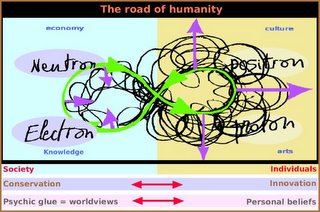Before jumping to the description of civilizations and culture, I guess that a summary of the thoughts presented earlier would be usefull.
1. The road of humanity.

This model is based on the "Wave theory" by Dr. Chaim H. Tejman
2. Worldviews.
We know from history that humanity went through 3 successive worldviews:
- animism: it lasted for tens of thousands and perhaps as long as hundred of thousands of years and ended with agriculture that developed as an indirect consequence of the last climate cahnge some 11,000 B.C.
- religions: were used and imposed as psychic glues to unify the individuals within the territory of the early kingdoms and empires starting approximately 3,000 B.C.
- modernity: is the system of thought based on individualism and private property that grew in Western European Christian lands as an direct consequence of the discovery of luxuries during the crusades and later discoveries.
- post-modernity: the sheer speed of scientific discoveries around the year 2000 and globalization that develops in parallel, plus the side-effects of modernity, those 3 factors are shaping a radically new approach towards reality from which a new post-modern worldview is emerging that will eventually be shared in the future by all on this earth.
3. Visual arts.
Worldviews glued the individuals within the boundaries of their societies. They were shaped in the minds of the "men of knowledge": shaman under animism, priests and monks under religions and aristocracy and new rich under early modernity. Visual sight having developed since tens of thousands of years, as humans' first and foremost sense, visual images were the best vehicle for transmitting the worldviews of the men of knowledge at the attention of their contemporaries. The production of such visual images is what has been referred to as art since the Renaissance (early modernity).
With a mature modernity the worldview of the men of knowledge of the day, the scientists, disconnected gradually from "the road of humanity". One of the direct consequences of this disconnect was for artists to be freed from the representation of imposed signs and they thus gained the freedom to represent what they want on their canvasses but by late modernity they had lost themselves in "whatever" is art...
In my next post about civilizations I'll try to sketch how the disconnect between knowledge and society at large occured.
Technorati tags:modern art, art theory, visual art, worldviews,
No comments:
Post a Comment